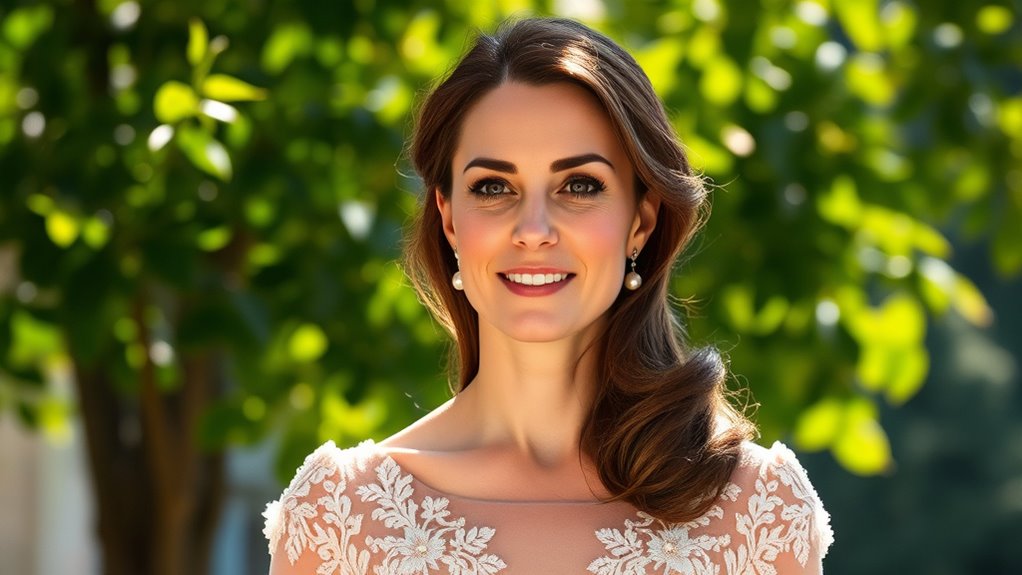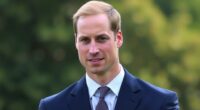Kate Middleton, now known as Catherine, Princess of Wales, is a modern royal who combines her dedication to charitable work with a strong sense of tradition. She married Prince William in 2011 and quickly became a prominent public figure. With her focus on family, mental health, and childhood development, she supports key causes and maintains a high-profile yet relatable role within the monarchy. To discover more about her life, roles, and ongoing projects, keep exploring her story in detail.
Key Takeaways
- Catherine, Princess of Wales, formerly Kate Middleton, is the wife of Prince William and a prominent member of the British royal family.
- She gained the title Princess of Wales after her marriage, following traditional royal customs and ceremonies.
- Educated at the University of St Andrews, she has a background in History of Art and active involvement in charitable work.
- She supports mental health initiatives, early childhood development, and community engagement through various royal patronages.
- As Princess of Wales, she participates in official duties, public engagements, and advocates for social causes aligned with her role.
Early Life and Background
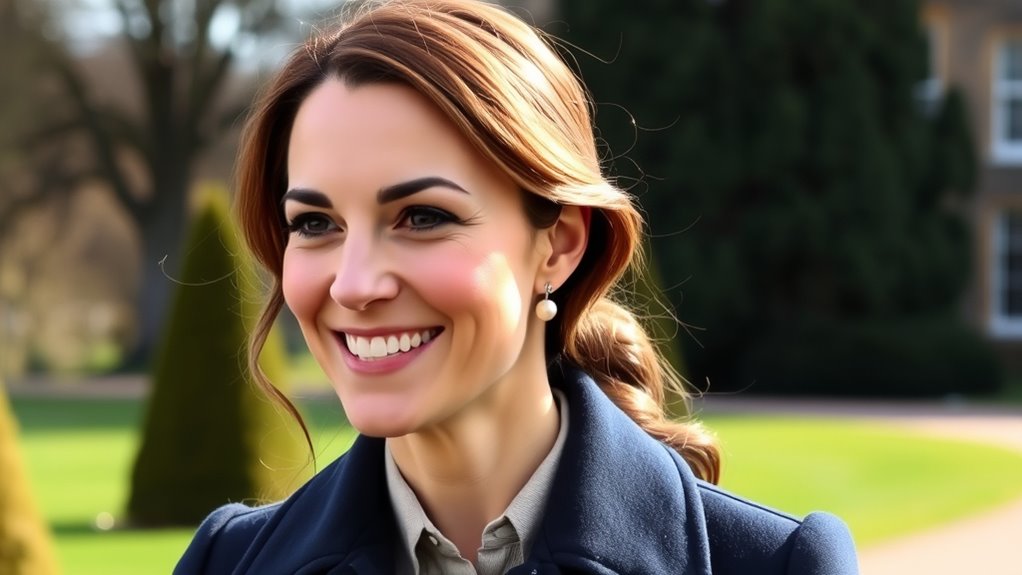
Kate Middleton was born on January 9, 1982, at Royal Berkshire Hospital in Reading, England. She’s the oldest of three siblings, with Pippa and James. Her parents, Michael and Carole Middleton, met working for British Airways—her father was a flight dispatcher, her mother a flight attendant. When her family moved to Amman, Jordan, from 1984 to 1986, Kate experienced life abroad. Her family later founded Party Pieces, a successful mail-order party supply business, which made them multimillionaires. Her maternal roots include coal miners and builders, reflecting working-class origins, while her paternal side has connections to British aristocracy. Growing up in a stable household, she attended prestigious schools, starting at nursery in Jordan, then in England, shaping her early years of education and social development.
A common goal tracking practice helped her stay organized and focused on her ambitions throughout her early life.
Education and Personal Relationships
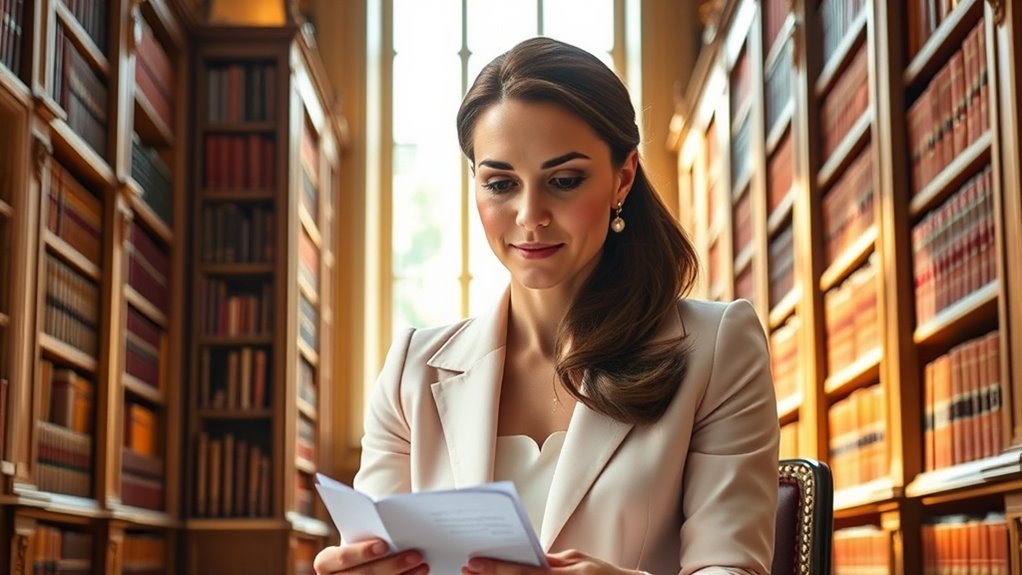
Her educational journey began at St. Andrew’s School in Pangbourne, where you developed a strong academic foundation. You then moved to Marlborough College, excelling in Chemistry, Biology, and Art at A-level. During this time, you demonstrated leadership in sports by captaining the hockey team and engaging actively in tennis, netball, and athletics. After Marlborough, you took a gap year, which included:
Starting at St. Andrew’s, progressing through Marlborough, and taking a diverse gap year shaped her resilient, global outlook.
- Studying at the British Institute in Florence
- Participating in Raleigh International’s Chile program
- Crewing boats for Round the World Challenge
- Gaining international exposure and leadership skills
You later enrolled at the University of St Andrews in 2001, earning a 2:1 degree in History of Art and playing hockey for the university team. Your diverse experiences shaped your global outlook and personal resilience. Additionally, you volunteered for various charitable projects during your studies, demonstrating a commitment to service and community involvement, which reflects the importance of cultural awareness in building a well-rounded perspective.
Royal Marriage and Titles

When Kate Middleton married Prince William, she gained the titles of Duchess of Cambridge and Princess of Wales, reflecting her new royal status. The wedding ceremony was a grand event with traditional elements that symbolized her entry into the royal family and its history. These titles and the ceremony itself highlight the importance of tradition and symbolism in royal marriages. Additionally, such titles often carry significance in royal culture, emphasizing the importance of heritage and social roles within the monarchy.
Royal Title Evolution
How have royal marriage and family changes shaped the titles held by the Duchess of Cambridge? When you marry into the royal family, your titles can evolve markedly. Initially, in 2011, Kate became Her Royal Highness The Duchess of Cambridge, gaining princess status and Scottish titles like Countess of Strathearn. After Queen Elizabeth II’s death in 2022, her titles shifted:
- She was elevated to Princess of Wales, following her husband’s new role.
- Her husband became Prince of Wales, increasing her prominence.
- She inherited subsidiary titles such as Duchess of Cornwall and Rothesay.
- The title change signified her increased responsibilities and royal standing. Royal title changes often reflect significant shifts in a royal’s duties and societal role.
This evolution of titles demonstrates the dynamic nature of royal duties and status. These transitions reflect how family and monarchy changes directly influence and elevate her royal titles, shaping her evolving role within the royal hierarchy.
Marriage Ceremony Significance
The marriage ceremony of Kate Middleton and Prince William at Westminster Abbey exemplifies the deep tradition and cultural significance behind royal weddings. You witness how this historic venue, hosting countless pivotal events, underscores the importance of continuity and heritage in royal customs. The service, conducted by notable figures like the Archbishop of Canterbury, features traditional vows, a ring exchange, and hymns that reflect centuries of religious and cultural practice. Musical performances by renowned choirs and orchestras highlight Britain’s rich cultural heritage. The ceremony’s grandeur, followed by celebrations at Buckingham Palace and a balcony appearance, reinforces the unity and stability symbolized by the royal family. Such a ceremony isn’t just about the vows; it’s a moment that cements royal status and tradition for generations to come. The wedding also included symbolic rituals such as the placing of the bride’s bouquet on the Grave of the Unknown Warrior, a tradition that emphasizes remembrance and royal continuity. Additionally, the ceremony often incorporates royal customs, which have been preserved through centuries to maintain a sense of identity and tradition.
Family and Children
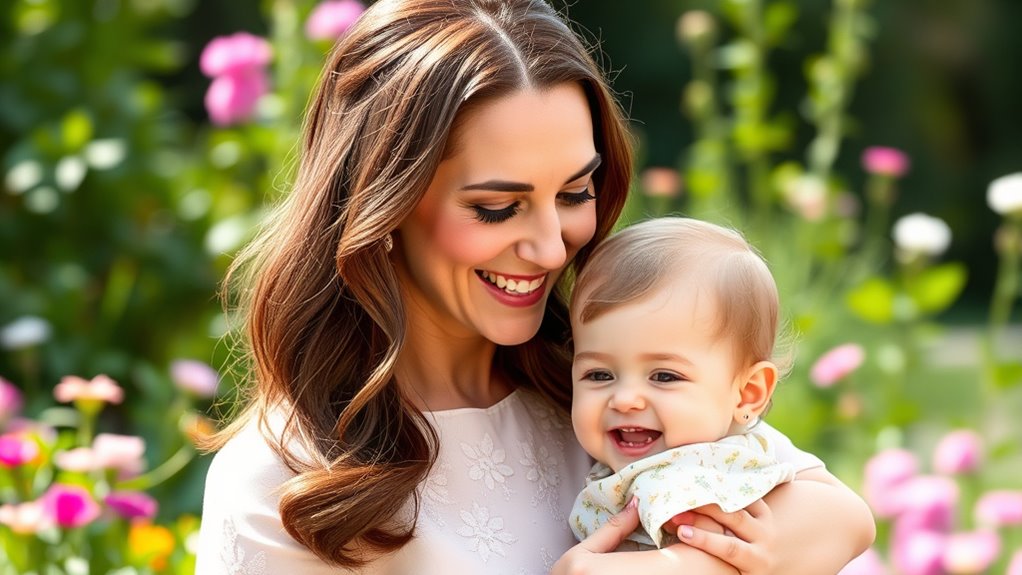
Kate Middleton and Prince William have three children whose names and birth dates reflect both their royal heritage and family history. You’ll find Prince George, Princess Charlotte, and Prince Louis occupy key positions in the line of succession, following their parents and grandfather, King Charles.
- Prince George was born on July 22, 2013, at St. Mary’s Hospital.
- Princess Charlotte arrived on May 2, 2015, at the same hospital.
- Prince Louis was born on April 23, 2018, also at St. Mary’s.
- Their names honor family members and royal traditions, blending personal and royal legacies.
- The children occasionally participate in public events, like the Platinum Jubilee or coronation, and generate high media interest. Their family life remains largely private despite public attention. Family privacy is an important aspect of their upbringing and public image.
Royal Duties and Public Engagements

As you explore Kate Middleton’s royal duties, you’ll see how she supports King Charles and Queen Camilla in their public roles. Her advocacy for child wellbeing highlights her dedication to making a meaningful difference through her engagements. These efforts demonstrate her commitment to strengthening the monarchy’s connection with the community and future generations. Her disciplined routine and focus on instilling core values in her children further exemplify her dedication to parenting philosophy, which influences her public initiatives. Additionally, her strategic investments and financial planning, such as understanding Gold IRA Rollovers, reflect her prudent approach to securing her family’s future.
Supporting The Queen and King
Supporting the monarchs has become an essential part of her role, with active participation in numerous royal duties that uphold tradition and public engagement. You help maintain the monarchy’s relevance by:
- Assisting Queen Elizabeth II for over 70 years, both domestically and abroad.
- Supporting King Charles III through engagements across the UK and Commonwealth.
- Participating in key events like Trooping the Colour, State Visits, and Remembrance Day ceremonies.
- Serving as a visible representative, strengthening public interest and continuity of royal traditions.
- Despite her recent health challenges, she continues to demonstrate her resilience by gradually resuming her duties and engaging with the public. Her involvement in various public engagements helps keep the monarchy connected with the people it serves.
These efforts ensure the monarchy remains connected to the people, fostering public loyalty and tradition. Your support helps facilitate royal responsibilities to the next generation, especially alongside Prince William, as the monarchy adapts to modern times.
Advocacy for Child Wellbeing
Building on her dedication to uphold tradition and connect with the public, Kate Middleton has increasingly focused on advocating for child wellbeing. She launched the “Happy Little Minds” pilot program, targeting emotional and social growth in preschoolers from underprivileged London areas. Partnering with charities like Barnardo’s and Place2Be, she supports mental health training for early educators and offers family guidance to promote emotional resilience. Kate also initiated the “Shaping Us” campaign, raising awareness about the critical first five years in a child’s development and emphasizing early intervention’s long-term benefits. Additionally, she helped develop a framework identifying 30 essential social and emotional skills, encouraging societal efforts to foster nurturing communities. The program aims to support approximately 150 children and their families during its pilot phase, ensuring targeted support for those most in need. Recognizing the importance of public engagement, she actively participates in events that highlight early childhood development. Through public events and collaborations, she champions the importance of early childhood support for a healthier, happier society.
Charitable Involvement and Advocacy
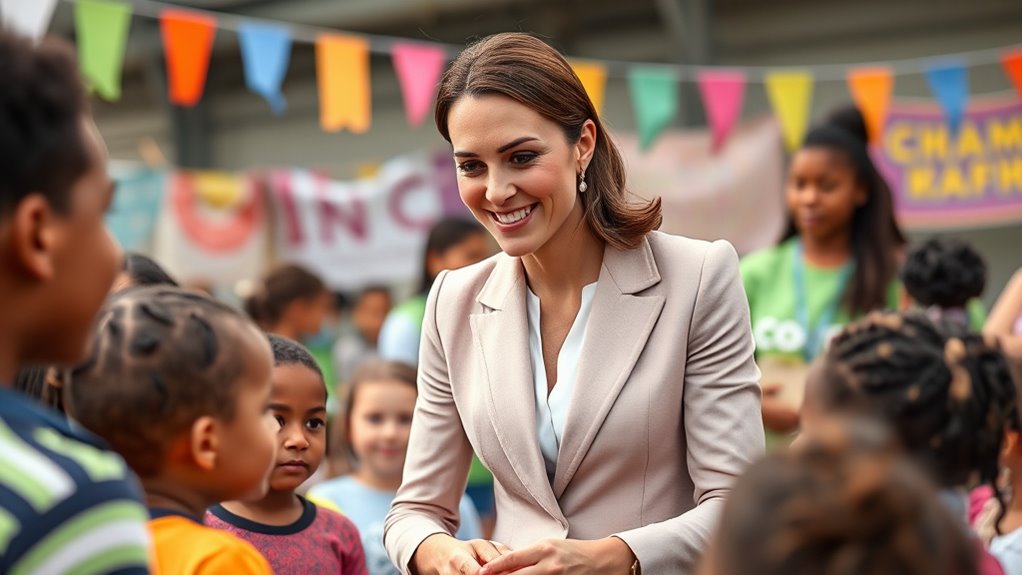
Kate Middleton actively champions a wide range of charitable causes, focusing on mental health, youth development, and community engagement. Her work through The Royal Foundation supports initiatives like Mentally Healthy Schools, Heads Together, and The Shaping Us campaign, emphasizing early childhood development. She also mobilizes partnerships with leaders, businesses, and communities to address societal issues. Her patronages reflect her focus, including The National Portrait Gallery, The Scout Association, SportsAid, and the Natural History Museum. She advocates for mental health through campaigns like Heads Together and supports crisis support services such as Shout 85258. Additionally, she champions programs for children and families, emphasizing early years and youth empowerment. Her community efforts include the annual Together At Christmas service, raising awareness and honoring community helpers. Her advocacy emphasizes the importance of early childhood development in shaping resilient individuals and communities.
Public Image and Media Perception
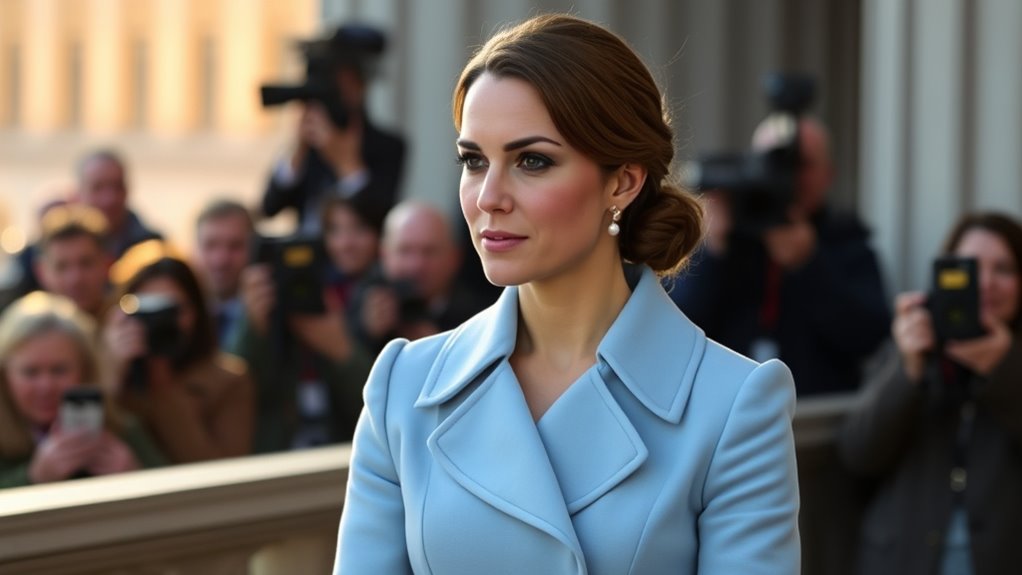
The Princess of Wales has cultivated a highly visible public image, consistently attracting media attention since her engagement in 2010. You’ve likely noticed how her every move is scrutinized, especially during health-related absences in 2024, which sparked rumors and conspiracy theories circulating on social media platforms like TikTok and X. Despite the intense media focus, she’s managed to maintain a positive reputation, with over 95% of people worldwide recognizing her. Public opinion polls show her popularity remains high, with many seeing her as a fashion icon—the so-called “Kate Middleton effect”—and a relatable symbol of modern royalty. Her balanced approach of discretion, charity work, and style influence keeps her in the public’s favorable view, even amid media scrutiny. The name Katherine remains a popular choice among royal family members and the public alike, reflecting her timeless appeal and cultural significance.
Personal Growth and Modern Royal Role

Personal growth has played a central role in shaping her modern approach to royal responsibilities. You’ll notice she maintains a disciplined daily routine, balancing motherhood, royal duties, and personal well-being. Her structured schedule includes:
Personal growth drives her balanced, disciplined approach to modern royal responsibilities.
- Dividing time carefully among parenting, supporting the heir, and engagements.
- Engaging in intense workouts like running, tennis, CrossFit, yoga, and cycling.
- Pursuing creative hobbies such as photography and drawing for mental clarity.
- Championing children’s mental health through charity visits and advocacy initiatives.
- She meticulously plans her days to maximize her time management and responsibilities, ensuring she fulfills her various roles effectively.
This commitment to self-improvement and resilience, rooted in her education and upbringing, enhances her leadership. She exemplifies a contemporary royal who actively integrates personal growth with societal impact, redefining the modern role of royalty in today’s world.
Frequently Asked Questions
What Are Catherine’s Favorite Hobbies and Interests?
Your favorite hobbies and interests include photography, where you capture special moments of your family and contribute to official royal portraits. You enjoy staying active through tennis, cold water swimming, and supporting your children’s sports like horseback riding and gymnastics. You also love playing the piano, gardening, and making jam, which help you stay connected to tradition and balance your busy royal duties with creative and relaxing pursuits.
How Does She Balance Royal Duties With Family Life?
Imagine a delicate dance where every step balances grace and purpose. You manage this by choosing only meaningful engagements, blending family time with royal duties like threads weaving a tapestry. You prioritize your children’s stability, often opting for private family moments, while thoughtfully assembling a trusted team to support your evolving role. This careful choreography allows you to nurture your family and serve your duties without losing sight of what matters most.
What Personal Challenges Has She Faced Publicly?
You face many personal challenges publicly, including a cancer diagnosis in 2024 that requires chemotherapy, leading you to adjust your schedule and priorities. You’ve also endured significant family losses, like Prince Philip and Queen Elizabeth, which tested your resilience. Public scrutiny adds pressure, but you openly prioritize your health, mental well-being, and family, showing strength and transparency while managing emotional stress and maintaining your royal duties.
How Does She Influence Royal Traditions and Modernization?
Like a beacon guiding ships, she influences royal traditions and modernization by expanding her public role, taking on new patronages, and embracing social media. You see her blend tradition with relatability, making royal fashion accessible and championing sustainability. She modernizes the monarchy by connecting with people, balancing ceremonial duties with active public engagement, and redefining royal relevance for a new generation—ensuring the monarchy stays relevant and vibrant in today’s world.
What Are Her Future Plans Within the Royal Family?
Your future plans involve shifting into a more strategic role as queen consort, building a trusted advisory team, and refining operational strategies. You’ll focus on quality over quantity in public engagements, balancing visibility with health needs. You aim to support the royal succession through modern parenting, while emphasizing resilience and influence gained from recent challenges. Your approach centers on impactful, selective duties, ensuring long-term stability and relevance for the royal family.
Conclusion
As you follow Kate Middleton’s journey, it’s clear she’s blossomed into a beacon of grace and strength, steering her royal role like a steady ship through stormy seas. Her growth reflects a modern royal’s evolution—balancing tradition with progress. With every step she takes, she proves that even in the grand palace, authenticity and compassion shine brighter than any crown. Kate’s story is a shining star guiding the future of royalty with warmth and purpose.

